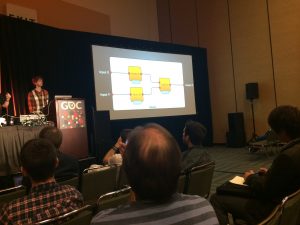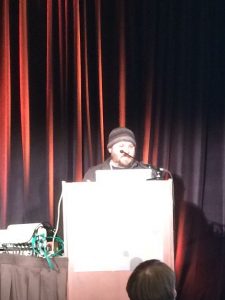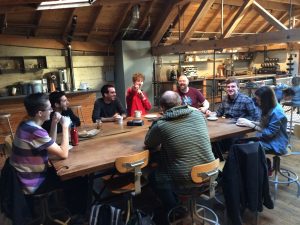
I intended to have this up last week but recovering from GDC was a fulltime job and the proverbial dog ate my homework when Google Docs made the rough draft of this article disappear. However at the time of writing the GDC Vault has not updated with audio/video of the event so hopefully this post will have a more timely release around the same time as GDC Vault. All of the photos were taken on my phone (apologies!) except the above header which is courtesy of the GDC website.
Lets get to the talks!
The first day of GDC had the Audio Bootcamp hosted by good friends of Designing Sound: Garry Taylor and Damian Kastbauer. It was super super informative but the talks were super short and not the easiest to take notes during! So instead I live tweeted as much as I could so please check out my Twitter feed from around that time and more importantly check it out on the GDC Vault.
“The Next-Gen Dynamic Sound System of Killzone Shadow Fall” was a great talk by Andreas Varga and Anton Woldhek from Guerilla Games. Their talk was centered on how for Killzone: Shadowfall they built a nextgen sound system from scratch that had an integrated asset pipeline and workflow. They used a node-based system like Kismet that compiled to C++ code. This system was created with very small nodes which allowed the designers to create complex and dynamic audio systems without the need of a programmer. This system was even later adopted by rigging and gameplay teams art the studio.

They also discussed and showed off a great enviromental sound system made in Nodes rather than requiring 3 months of coding work. With it they set up gunfire to make objects emit a resonance sound based on their material. This sub-system could and should be an article in itself so check it out on the GDC Vault!
”Next Gen Audio in Killer Instinct” was a fabulous talk by Mick Gordon and Jean-Edouard Miclot. Mick discussed a wonderful sound system set up in Wwise and Jed talked about sound design which will be the focus of my recap.
The beginning of the talk focused on the lineage of Killer Instinct as an arcade game meant to grab attention in a noisy arcade where the first loudness war began. One super-interesting anecdote to a game history nerd like myself was how they tried to replicate the original game’s announcer by re recording the voice actor who tried to match the performance. Their results were not what they were looking for but fortunately they were able to obtain the original tape recordings and process those into what was eventually used! Game Audio Archaeology!
Jean-Edouard Miclot showed off how many of the hits were made for Killer Instinct. Using a ping pong paddle on a leather chair along with using FilterFreak, C4 Compressor and Denosier he recorded/designed hundreds of takes for low, medium and heavy impacts. For the super power moves triggered when a meter is filled during gameplay; everything from cougar sounds, female whispers and monster growls were used.
A highlight of the presentation was a ~1 meter tall tesla coil that was recorded for electric sounds. Some other cool techniques were: splashing water on a hot stove burner, stretching duct tape across a table, the sound of a clothes iron and Jed even pulled out a rubber band and performed springy stretch sounds with it for the audience.
I went to only the first day of the “Game Audio Education Roundtable” out of the three days it went on but there was a lot to think about just after the first day!
The discussion was centered on trying to evolve traditional music programs into more a robust curriculum that gives the full overview of what game audio offers and shifting to pragmatism in the programs to make the graduates viable for gainful employment.
Some of the suggestions from the roundtable were: to teach more programming rather than FMOD or Wwise middleware, to allow more procedurality and adding the core skill of programming to be a stronger designer. Another and almost opposite suggestion was to focus on the artistic side of sound design rather than technical when considering the time limitations of the courses.
I did not make it to the other 2 days (it was a very busy week!), but I am sure they were great discussions with wonderful takeaways.
I also caught “Rulebooks on Fire: Looking at the Impact of Indie on the Voice Industry” which was a panel hosted by Michael Csurics and included Jennifer Hale, Chip Beaman, Steve Gaynor, and David Chan.
I went to this talk because as a freelance sound designer and occasional composer who deals entirely with indie projects; it seemed very wise to get as much info about indie studies dealing with VO as possible. The discussion ranged from the benefits of union vs non-union, how indie devs could educate themselves and even what indie developers can expect to pay for an actor.
This panel was super cool and informative and like all of the talks mentioned here; check it out at the GDC Vault for specific numbers and facts.
“Indie Audio: Contracts, Compensation, Communication & Conception” by Richard Ludlow, Creative Director at Hexany Audio was another great talk for a freelance audio professional dealing with audio to check out. This talk also featured a huge amount of practical information and hard numbers. Richard went over a contract point by point, how much to charge, different ways to charge and how to communicate with the developer.
This talk more than any other requires Vault access simply to be able to reference the exact ideas and figures he uses. I will be checking out the talk again just to copy his spreadsheet layout!
“How to Create Hardcore, Realistic Shooter Audio with a Non Hardcore Budget” by Chris Rickwood and Lennie Moore

Continuing with the indie theme of the talks I chose to go to; this talk was about making the best with the time, budget and other limited resources you have available on smaller projects. Chris and Lennie are also both great presenters so I knew the audience was going to be in for a good time and they did not disappoint. Chris laid out a super cool and quick workflow of loading and laying gunshot samples in Native Instruments’ Battery, tweaking transients and effects inside the plugin and getting some great results out of a drum sampler! Chris also used Battery to generate looping automatic gun sounds from one sample by modulating for note on with notchEQ and randomizing sample start, saturation and pitch. Other cool tricks Chris discussed were using thunder trails for the tails of gunshots or taking one sample and send it to 2 different reverbs on 2 different channels; one panned hard right and one panned hard left for a different way to get interesting reverbs.
The presentation “The Sound of Grand Theft Auto V” that was *the* talk of GDC 2014. I unfortunately missed it but having talked to those who attended it and presenter Alastair MacGregor has gotten me super excited about checking it out on the vault. Luca Fusi has written a great recap of the talk as well as the “Aural Immersion: Audio Technology in The Last of Us” here on his site.
“Creature Sound Design” by Stephan Schutze was an interesting talk which wasn’t about the specifics and technicalities of designing creature sounds like I expected. Stephan’s discussion focused on adding more depth and characterization to creatures than is currently done in games by using reality for inspiration of how to design the creatures (and he strongly suggested getting good animal recordings for source).
Being a great recordist, Stephan had many suggestions when planning animal recordings:
-What time during the year is the species most vocal?
-How much variation is there in their vocalizations throughout the year?
-How does the behavior change during day/night cycle?
-Does the vocal behavior alter in different geographical locations?
-Are you recording at the right time?
-What range of movement around the creature’s habitat occurs and can it be covered with
-Where are the best positions to set up the equipment?

Stephan also showed video of his own cat Onyxia’s vocalizations and his interpretation of her different meows and calls in the context of how they could be used effectively to give the cat a personality and voice. Also shown was Stephan’s work on Jurassic Park: Operation Genesis and how even in a PS2-era game; he was able to enhance the characterization of the dinosaurs (which had very simple animation) with audio.
“Mad Skillz For Directing Dialogue” by DB Cooper was a wonderful presentation (as always from DB) full of tips for directing VO actors in a session. Useful tips like; “don’t give line reads ( as it is insulting to the actor). if you do give line reads; don’t give the exact line — use paraphrased or similar spirited line” and “don’t interrupt in the middle of a line” as well as the suggestion of recording a “shoot the breeze” conversation with the actor at the beginning of a session and play it back to the actor later so they hear how they sound in natural conversation– all very useful information in an action packed talk that should be heard to get the full effect (including DB doing some great voices herself!).

The last talk I saw at GDC 2014 was “Why You Didn’t Get the Gig” by Jesse Harlin. This talk was full of great insight from a person who has hired many audio professionals during his long tenure at Lucasarts. Pointers like: “wealth of experience = short resume & dearth of experience = long resume” and know your background, angles and connection in video chats were among the many useful tidbits. Additionally Jesse’s talk was interspersed with adorable videos by Matt Piersall which can be viewed here.
If you followed the @DesigningSound twitter account on the Thursday of GDC you saw our livetweets of the 12th Annual GANG Awards but you can also check out the winners here.
Also check out The Game Audio Podcast which recorded a roundtable discussion each morning at a coffee shop called “Sightglass”. Yours truly only made it to the first morning’s recording because they record in the morning and 7am is really early at GDC.
Also check out the podcast Beards, Cats and Indie Game Audio Episode 3 for their recap of GDC.
Thanks to everyone who came up and said how much they enjoy reading Designing Sound. We don’t do this for the praise but it is nice to hear when we get it!

Thanks for the shout-out- glad you found the talk helpful! :)
Thanks for the recap!